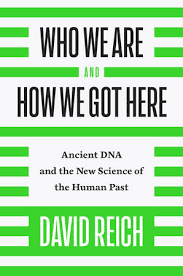 It looks as if the vast majority (95% or more depending on the population) of the ancestry of non-African humans derives from a population expansion which began around ~60,000 years ago. Before this period some researchers argue there was a non-trivial period of isolation. The “long bottleneck” (David Reich alludes to this in Who We Are and How We Got Here: Ancient DNA and the New Science of the Human Past). For the vast majority of humans then the last 60,000 years is characterized by a branching process, some reticulation (e.g., South Asians merge West and East Eurasian lineages) between these branches from a common ancestor, as well as introgression from archaic lineages like Neanderthals and Denisovans.
It looks as if the vast majority (95% or more depending on the population) of the ancestry of non-African humans derives from a population expansion which began around ~60,000 years ago. Before this period some researchers argue there was a non-trivial period of isolation. The “long bottleneck” (David Reich alludes to this in Who We Are and How We Got Here: Ancient DNA and the New Science of the Human Past). For the vast majority of humans then the last 60,000 years is characterized by a branching process, some reticulation (e.g., South Asians merge West and East Eurasian lineages) between these branches from a common ancestor, as well as introgression from archaic lineages like Neanderthals and Denisovans.
Though I do accept that it seems that modern humans probably migrated out of Africa before 60,000 years ago, mostly due to the results from archaeology, I think the genetic evidence is strong that these groups contributed very little genetically to contemporary populations.
The situation within Africa is very different. Being conservative it seems likely that the Khoisan ancestral lineage diverged from some other Africans ~200,000 years ago. I say conservative because there are researchers who want to push the divergence much further back. Additionally, several different research groups are now converging in a result that West Africans are a mixture between eastern Sub-Saharan Africans (think the population ancestral to Mota in Ethiopia) and a lineage basal to all other humans. That means that the Khoisan are not the most basal, so even assuming the conservative 200,000 year divergence point for Khoisan, modern humans share a common ancestor earlier than 200,000 years ago.
 The upshot here is that around 75 percent of the history of modern humans is within (greater)* Africa. The distinctive “Out of Africa” bottleneck and expansion defines most humans only in the last 25 percent of the history of our species. And, within Africa, the dynamics were very different. The biggest difference is that African populations are not defined by a large number of lineages emerging and diverging around the same period, because there wasn’t a massive and singular expansion within Africa analogous to what occurred outside of Africa (at least until the recent past, with the Bantu expansion). That’s why there’s deep structure within Africa today between groups as divergent as the Bantu, Mbuti, Hadza, and Khoisan.
The upshot here is that around 75 percent of the history of modern humans is within (greater)* Africa. The distinctive “Out of Africa” bottleneck and expansion defines most humans only in the last 25 percent of the history of our species. And, within Africa, the dynamics were very different. The biggest difference is that African populations are not defined by a large number of lineages emerging and diverging around the same period, because there wasn’t a massive and singular expansion within Africa analogous to what occurred outside of Africa (at least until the recent past, with the Bantu expansion). That’s why there’s deep structure within Africa today between groups as divergent as the Bantu, Mbuti, Hadza, and Khoisan.
The term “Basal Eurasian” kind of makes sense in the non-African context because of the singular importance of divergence between lineages in the first 10,000 years or so after the “Out of Africa” event. I’m not sure “Basal human” makes as much sense because there wasn’t a singular event within Africa that allowed for the emergence of modern humans. Rather, it was a process, and probably quite resembles something like multiregionalism.
* Some wiggle room here for the likelihood that modern humans were long present in the liminal Near East.